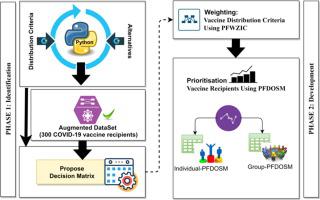Journal of Advanced Research ( IF 10.7 ) Pub Date : 2021-08-21 , DOI: 10.1016/j.jare.2021.08.009 O S Albahri 1 , A A Zaidan 1 , A S Albahri 2 , H A Alsattar 1 , Rawia Mohammed 1 , Uwe Aickelin 3 , Gang Kou 4 , F M Jumaah 5 , Mahmood M Salih 6 , A H Alamoodi 1 , B B Zaidan 1 , Mamoun Alazab 7 , Alhamzah Alnoor 8 , Jameel R Al-Obaidi 9

|
Introduction
The vaccine distribution for the COVID-19 is a multicriteria decision-making (MCDM) problem based on three issues, namely, identification of different distribution criteria, importance criteria and data variation. Thus, the Pythagorean fuzzy decision by opinion score method (PFDOSM) for prioritising vaccine recipients is the correct approach because it utilises the most powerful MCDM ranking method. However, PFDOSM weighs the criteria values of each alternative implicitly, which is limited to explicitly weighting each criterion. In view of solving this theoretical issue, the fuzzy-weighted zero-inconsistency (FWZIC) can be used as a powerful weighting MCDM method to provide explicit weights for a criteria set with zero inconstancy. However, FWZIC is based on the triangular fuzzy number that is limited in solving the vagueness related to the aforementioned theoretical issues.
Objectives
This research presents a novel homogeneous Pythagorean fuzzy framework for distributing the COVID-19 vaccine dose by integrating a new formulation of the PFWZIC and PFDOSM methods.
Methods
The methodology is divided into two phases. Firstly, an augmented dataset was generated that included 300 recipients based on five COVID-19 vaccine distribution criteria (i.e., vaccine recipient memberships, chronic disease conditions, age, geographic location severity and disabilities). Then, a decision matrix was constructed on the basis of an intersection of the ‘recipients list’ and ‘COVID-19 distribution criteria’. Then, the MCDM methods were integrated. An extended PFWZIC was developed, followed by the development of PFDOSM.
Results
(1) PFWZIC effectively weighted the vaccine distribution criteria. (2) The PFDOSM-based group prioritisation was considered in the final distribution result. (3) The prioritisation ranks of the vaccine recipients were subject to a systematic ranking that is supported by high correlation results over nine scenarios of the changing criteria weights values.
Conclusion
The findings of this study are expected to ensuring equitable protection against COVID-19 and thus help accelerate vaccine progress worldwide.
中文翻译:

用于 COVID-19 疫苗剂量接受者的新型动态模糊决策框架
介绍
COVID-19 的疫苗分配是一个基于三个问题的多标准决策 (MCDM) 问题,即识别不同的分配标准、重要性标准和数据变化。因此,通过意见评分方法 (PFDOSM) 确定疫苗接受者优先级的毕达哥拉斯模糊决策是正确的方法,因为它使用了最强大的 MCDM 排序方法。然而,PFDOSM 隐含地权衡了每个备选方案的标准值,这仅限于显式地对每个标准加权。鉴于解决这一理论问题,模糊加权零不一致性(FWZIC)可以作为一种强大的加权 MCDM 方法,为具有零不一致性的标准集提供显式权重。然而,
目标
本研究提出了一种新的齐次毕达哥拉斯模糊框架,用于通过整合 PFWZIC 和 PFDOSM 方法的新公式来分配 COVID-19 疫苗剂量。
方法
该方法分为两个阶段。首先,根据五项 COVID-19 疫苗分发标准(即疫苗接受者成员资格、慢性病状况、年龄、地理位置严重程度和残疾),生成了一个包含 300 名接受者的增强数据集。然后,根据“接收者列表”和“COVID-19 分布标准”的交集构建决策矩阵。然后,集成了 MCDM 方法。开发了扩展的 PFWZIC,随后开发了 PFDOSM。
结果
(1) PFWZIC 有效地加权了疫苗分配标准。(2) 在最终分配结果中考虑了基于PFDOSM 的组优先级排序。(3) 疫苗接种者的优先顺序受到系统排名的影响,该排名得到了九种不断变化的标准权重值情景的高相关性结果的支持。
结论
这项研究的结果有望确保针对 COVID-19 的公平保护,从而有助于加快全球疫苗研发进程。



























 京公网安备 11010802027423号
京公网安备 11010802027423号